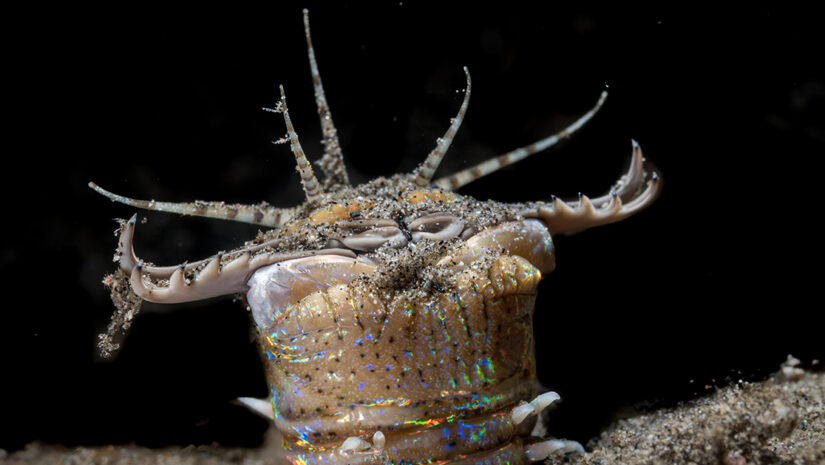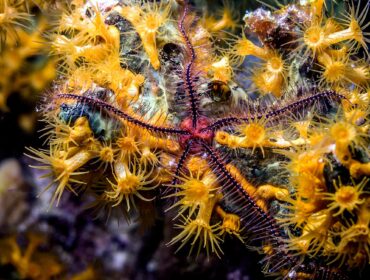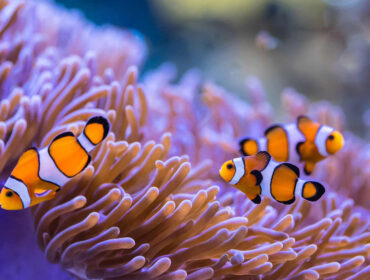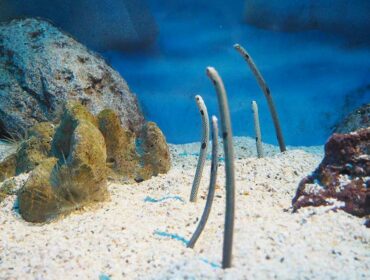Not all sea creatures are blessed with good looks. Like the flabby blobfish and spooky frilled shark, odd-looking sea creatures comprise most marine fauna. Since their appearance doesn’t conform to our notion of beauty, these animals don’t get the same attention and conservation funding as whales, reef sharks, and orcas.
But while strange animals like the frogfish, blue dragonfish, and gob-faced squid look like evolution skipped them, on the inside, it’s quite the opposite. Their biological makeup and genetic predisposition are beyond fascinating. Let us introduce you to nine of the most bizarre sea creatures lurking in the world’s oceans, from the shallows to the deep abyss.
Bobbit Worm
First on the list is the Bobbit worm, arguably one of the most terrifying and bizarre sea creatures living within the seabed.
Eunice aphrodite, or the bobbit worm, is a predatory polychaete worm that lives on the ocean floor at depths of 10 to 40 meters in the Indo-Pacific. The Bobbit worm is omnivorous but has some unique features that make it an exceptionally skilled and ruthless hunter. Growing up to three meters in length, this clever worm buries itself in the substrate, which could be gravel, coral, sand, or even mud, leaving only its five antennae protruding from the sea floor.
When these antennae are stimulated by passing prey, the bobbit worm bites with its razor-sharp teeth, pulling its victim into the substrate to be consumed. This bite can be delivered quickly, slicing the prey in half! But it’s not just the Bobbit worm’s bite you should fear; it’s also covered in stinging bristles that can result in permanent numbness in the area of human flesh that touches it. Check out what happens when an equally fearsome lionfish stumbles unwittingly across the lair of a Bobbit worm.
Living Rock
Contrary to its name, living rock is a tunicate, a marine invertebrate sometimes called a sea squirt or piure in Chile and Peru. Other aquatic invertebrates, like coral, also have soft living parts inside a hard shell, but living rock takes it to an entirely new level.
Living rock or Pyura chilensis does not move—ever. Instead, it survives by taking in water and extracting microorganisms for food while remaining in the same place throughout its lifetime, making it appear like another rock on the seabed. When cut open, however, it reveals a vibrant red, semi-solid flesh with clear fluid—its blood. Some locals consider the meat a delicacy but somewhat of an acquired taste.
One of the most interesting facts about these strange sea creatures is how they reproduce. The picture begins life as a male, but as it grows and approaches reproduction age, it becomes hermaphroditic, meaning that it has both male and female traits. When it’s fully mature, it will send eggs and sperm into the water, relying on ocean currents and chance to fertilize the eggs. This species is found in clusters, but even a single organism can reproduce without help from its friends.
Sea Angel
Nearly every diver has seen the James Cameron blockbuster The Abyss. And who could forget those weird sea creatures that end up saving everyone’s butt several times in the movie? While the creatures in that tale were intended to have a supernatural affectation, many keen minds have noted the similarities between those fictional beings and actual marine organisms, specifically salps, pyrosomes, and a little creature called the gymnosomata or the sea angel.
Although its moniker suggests an otherworldly creature, the sea angel is nothing more than a pelagic gastropod mollusk without the protective shell the rest of its kind has. The feet of these free-swimming organisms have evolved into wing-like appendages that help them swim through the water column. They feed almost exclusively on sea butterflies, tiny pelagic swimming sea snails with similar wing-like appendages. While sea butterflies have a shell, this doesn’t stop the sea angel from consuming them using a series of hooks and a toothed radula. Due to its transparent body, the entire act of feeding is visible from beginning to end. Check out this fascinating footage of a sea angel in the wild.
Tardigrade
The tardigrade, or “water bear,” may be a microscopic organism (no more than 2 mm in length), but it’s one of the most remarkable creatures on the planet. Our cute little water bear can live in environments where other insects can’t. You’ll also find it in every corner of the Earth: from volcanic hot springs to the poles, from the top of the Himalayas to ocean depths of more than 14,000 feet.
Researchers have even launched tardigrades into orbit to see whether they could withstand the vacuum of space, not to mention the intense radiation, a journey from which they returned completely unscathed. Various tests show that tardigrades can withstand temperatures as low as -459F and as high as 304F while simultaneously taking on 1,000 times the radiation other animals can stand.
Not to be outdone by itself, the tardigrade can also go nearly a decade without water by entering a dormant state called cryptobiosis. Rehydration brings it back to life, a cycle that the tardigrade can repeat as often as necessary throughout its life, significantly expanding its life span. The tardigrade’s curious abilities have led some scientists to speculate on its origin and explore the possibility that it’s a migrant from another planet.
Tardigrades are so abundant in our ecosystems that some foraged dry moss, beach sand, seawater, soil, or freshwater sediment holds at least one, whether active or in cryptobiosis. So grab yourself a microscope, a petri dish, and some natural debris, and try hunting the world’s most familiar “bear”!
Lumpsucker
Of all the strange ways sea creatures have evolved over the millennia to better adapt to their environment, one that never fails to elicit curiosity is the lumpsucker. With a name based purely on visual characteristics, the lumpsucker is a small, rotund fish that resembles a puffer fish. But the exciting part of its anatomy is its pelvic fins, which have evolved into adhesive discs or “suckers.” These sucker fins allow the lumpsucker to stick securely to ocean substrates, where it can remain stationary while it seeks out prey.
Like the puffer fish, this bizarre little fish is not a strong swimmer, relying only on a tail fin and small pectoral fins for propulsion through the water column. It depends on its ability to adhere to surfaces for safe feeding and self-defense to survive in the wild. The lumpsucker feeds on sessile invertebrates, including marine worms, mollusks, and small crustaceans. Some pelagic species prey on jellies, which this awkward fish can quickly pursue and overtake. Because of their comedic appearance and relatively docile temperament, lumpsuckers are popular among aquarists. Check out a Pacific Spiny Lumpsucker holding it down inside a tank, capturing the bemusement of a tiny Crescent Gunnel.
Sarcastic Fringehead
The sarcastic fringehead hails from the blennioid suborder of the Chaenopsidae family and is essentially like all other blennies in every way but one: that enormous mouth. It burrows into the substrate, holes up in coral or even the abandoned shells of a hermit crab, and is ruthlessly defensive of its territory.
The sarcastic fringehead poses no threat to humans except for its alarming appearance. But this look wards off predators and other passersby from lingering too long in its burrow. Should another sarcastic fringehead take up residence too close, however, that’s when the show begins. Both fish will expand their formidable mouths and needle-like teeth, and if that doesn’t do the trick, then there’s nothing left to do but begin wrestling. Mouth wrestling. Until one of them skulks away, ashamed of its weak mouth.
This behavior makes them fierce father figures as well. The female sarcastic fringehead will lay her eggs in an abandoned shell or other relatively concealed opening, leaving dear old dad to it. Unfortunately, she will never be around to witness the birth of her children because even she isn’t exempt from the “Get off my %@#& lawn!!”
You don’t even have to go somewhere exotic to find these weird sea animals; sarcastic fringeheads populate areas of the Pacific Ocean between three and 73 meters deep, from San Francisco, California, down to central Baja, California, in Mexico. If you run into one on a dive, feel free to engage in a battle of wits, but remember, sarcasm hurts everyone. In the meantime, watch this fantastic sarcastic fringehead fight for its right to dominate the seafloor.
Melibe leonina
Here at Scuba.com, we are huge fans of nudibranchs for their fantastic variety of shapes, colors, and sizes, not to mention that they’re found in virtually every sea across the globe. Our favorite species is the Melibe leonina, more commonly known as the hooded nudibranch or the lion’s mane nudibranch, found primarily in colder waters and kelp forests off the western coast of North America.
This bizarre sea creature travels the same way other nudibranchs do, propelling itself through the water with a side-to-side gyration. It is a predatory species, feeding on minute creatures that proliferate the water column, including amphipods, copepods, small mollusks, larvae, ctenophores, and even jellyfish.
The jelly is the most appealing form of prey for the Melibe leonina. The sensory tentacles it uses to detect prey resemble the appearance of a jellyfish, making it an easy target. When a jelly finds its way inside the oral hood, it shuts close rapidly with the tentacles intertwined to bring the food into its mouth—like Venus flytraps of the sea. The entire body of this weird sea animal is translucent, with four to six pairs of paddle-like appendages that can be shed when threatened, distracting the attacker while it makes its escape.
One of the most curious features of the Melibe leonina is its odor (similar to that of fruit-flavored gum), which it emits when removed from the water or kept in captivity. For this reason, along with their flower-like appearance, a group of this species is called a bouquet. Check out these incredible videos of the Melibe leonina in action.
Dumbo Octopus
Cephalopods have long captured the human imagination, whether in bemused curiosity or morbid fear. Fear is an understandable reaction, as squid and octopus have been stigmatized over centuries as fearsome and strange sea creatures of the deep—man-eaters capable of disappearing entire ships in the still of the night. Although they are predatory creatures, the typical diet of a cephalopod consists of crustaceans, shelled mollusks, and gastropods, prey that can be pierced with their sharp beak and torn to pieces—not the dense and awkward bone structures of humans. Indeed, cephalopods have much more reason to fear man than vice versa!
But one cephalopod that most certainly elicits “ooh’s” and “aww’s” rather than terrified panic is the Grimpoteuthis, or more adorably, the Dumbo octopus. Named for a pair of fins that protrude from either side of its head, the Dumbo octopus is a bathypelagic creature residing in depths of 1,000 to 4,000 meters, with reports of sightings as deep as 7,000 meters. This sea region receives no natural light, resulting in clever adaptations of the living creatures.
Although the Grimpoteuthis can propel through its funnel, arms, and ear-like fins, it hovers over the seabed, searching for worms, amphipods, and crustaceans to swallow whole. Instead of the usual crushing and tearing methods that other cephalopods employ, this method of predation allows this unusual cephalopod to conserve energy—a valuable resource in these Cimmerian reaches of the ocean.
Squidworm
The Teuthidodrilus, or squidworm, is a recently discovered species of marine polychaete worm. In 2007, marine biologists found this interesting sea worm in the western part of the Celebes Sea, a deep oceanic basin in the depths of the Philippines, part of the Coral Triangle. This marine worm has intrigued scientists everywhere due to its unique body structure and recent discovery.
The squidworm is measured to be nearly four inches long, quite sizable for a marine worm. It is named for its head, which looks covered in squid-like tentacles. This worm has various appendages, some even longer than its body. Eight arms are used for breathing, and two long, coiled appendages are used for feeding. Six pairs of sensory organs emerge from its head to provide the squidworm the ability to taste and smell, and propulsion paddles are present down the length of its body to allow upright swimming.
Not much is known yet about this type of marine worm
As a newly recognized species, scientists believe that its numerous appendages and odd body structure have a deeper meaning for this creature. Because of its strange body characteristics, the squidworm may be a transitional worm, evolving as it exists in two diverse habitats. The squidworm lives in an in-between area of the ocean, making it subject to conditions that are not typically the first choice of marine worms. It does not exist near the light-filled surface of the water, nor does it inhabit the dark, rocky seafloor.
The worm uses its two coiled appendages on its head to feed on plankton in the ocean water. It does not seem to be a predator, as it has only been noted to eat plankton and sinking particles of microscopic plants and animals. Multiple sets of observations have reported a profusion of this worm in the Celebes Sea, suggesting that it is pretty standard. The new type of marine worm is a captivating example of the continued discoveries of new species and the vast wonders of this world.




